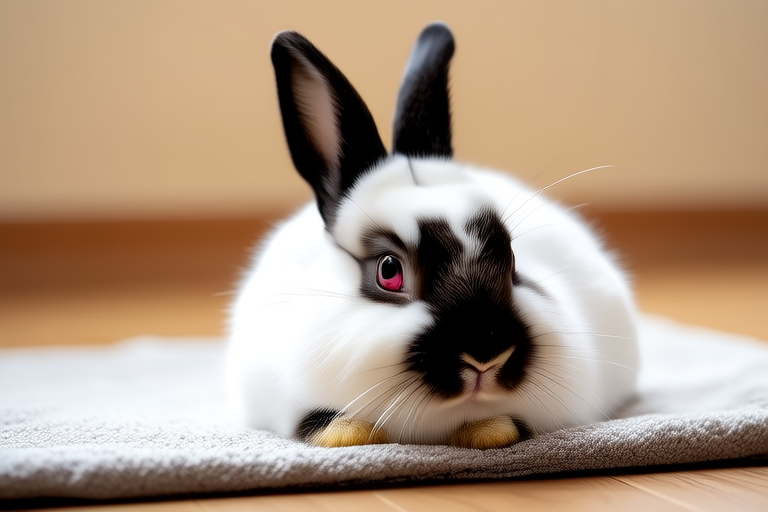Adorable and Unique: Raising a Hotot Rabbit as Your Pet
The world of pet rabbits is vast and varied, but one breed stands out for its unique appearance and charming personality: the Hotot rabbit. With its striking white fur and distinctive black eye rings, the Hotot rabbit is a true visual treat. This breed has become increasingly popular among pet enthusiasts for its adorable looks and gentle nature. In this article, we will explore the origins, care, and companionship of the Hotot rabbit, providing you with all the information you need to consider adding one of these delightful creatures to your family.
The Origins of the Hotot Rabbit
The Hotot rabbit, named after the town of Hotot-en-Auge in Normandy, France, was developed in the early 20th century by Eugenie Bernhard. Her goal was to create a rabbit that would have a pure white coat with dark eyes, and she succeeded in breeding the first true Hotot rabbit in 1920. Since then, the breed has gained recognition worldwide and is now cherished by many for its beauty and temperament.
Ideal Living Conditions for Hotot Rabbits
Hotot rabbits thrive in environments that provide them with ample space to move around and play. They require a spacious hutch or cage that allows them to stretch and hop comfortably. The ideal size for a rabbit hutch is at least 8 square feet per rabbit. Additionally, it’s essential to ensure the living area is well-ventilated and protected from extreme weather conditions. Indoor living can be suitable if proper space and exercise are provided.
Dietary Needs of Hotot Rabbits
A balanced diet is crucial for the health and longevity of your Hotot rabbit. Their primary food source should be hay, which aids digestion and keeps their teeth healthy. Fresh vegetables and fruits can be given in moderation as treats. Timothy hay is particularly recommended due to its high fiber content. It’s also important to provide fresh water daily, and avoid feeding them foods that are harmful to rabbits, such as chocolate, onions, or avocados.
Common Health Issues
Like all breeds, Hotot rabbits can be prone to certain health issues. One of the most common problems is dental disease, which can occur if the rabbit does not chew enough. Regular access to hay and chew toys can help prevent this. Other potential health concerns include respiratory infections and digestive issues. Regular veterinary check-ups are vital to maintain the health of your rabbit. Early detection and treatment of any health problems can significantly improve your rabbit’s quality of life.
Grooming Tips
Grooming is an essential part of caring for your Hotot rabbit. Their short, dense fur requires regular brushing to remove loose hair and prevent matting. Use a soft-bristled brush to gently comb through their coat. Bathing is generally unnecessary unless absolutely required, as it can stress the rabbit and disrupt their natural oils. Instead, focus on cleaning their ears and paws regularly. Keep an eye on their nails, trimming them when necessary to prevent overgrowth.
Training and Bonding
Training your Hotot rabbit can be both fun and rewarding. Start by teaching basic commands like coming when called or sitting still. Positive reinforcement, such as offering treats and praise, works best. Spend time playing and interacting with your rabbit every day to build trust and strengthen your bond. Gently handling your rabbit from an early age helps them feel comfortable and secure.
Behavior Traits
Hotot rabbits are known for their calm and docile nature, making them excellent pets for families. They are curious and enjoy exploring their surroundings, so providing them with toys and activities is essential to keep them mentally stimulated. These rabbits can coexist peacefully with children and other pets, but supervision is always recommended, especially during initial interactions. Their gentle demeanor makes them perfect companions for those looking for a quiet, loving pet.
Interaction with Children and Other Pets
Hotot rabbits are generally good with children, provided that the children are taught to handle them gently and respectfully. Supervised playtime can help foster a strong bond between the rabbit and child. When introducing your Hotot to other pets, proceed with caution and ensure that all animals are properly socialized. Some rabbits may take longer to adjust to new companions, so patience is key.
Responsible Adoption and Resources
Adopting a Hotot rabbit is a significant commitment that should not be taken lightly. If you’re considering bringing one into your home, make sure you’re prepared to provide the care and attention they need. Look for reputable breeders or shelters that prioritize the health and welfare of their animals. Once you’ve adopted your Hotot, there are numerous resources available to support you. Local rabbit clubs, online forums, and books about rabbit care can offer valuable guidance and advice. Joining these communities can connect you with other rabbit owners who share your passion and can provide practical tips and emotional support.
In conclusion, raising a Hotot rabbit as your pet is a rewarding experience that brings joy and companionship to your life. By understanding their unique needs and providing them with love and care, you can ensure that your Hotot rabbit thrives in your home. Whether you’re a first-time pet owner or an experienced rabbit lover, adopting a Hotot rabbit is sure to bring endless happiness and affection into your household.
